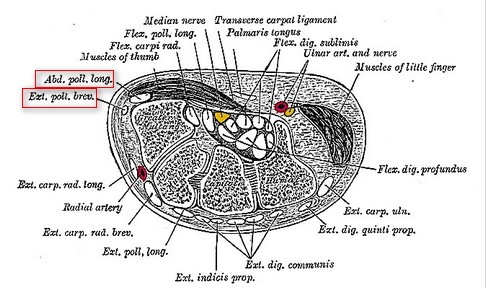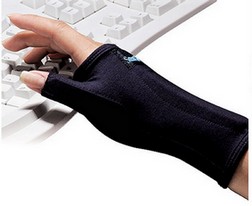Fritz De Quervain was a strong proponent of a general rather than specialist medicine. He was one of the earliest clinicians to identify embolism as a cause pulmonary infarction that was often diagnosed as pneumonia in recovering surgical patients. He identified and researched the syndrome that now bears his name in 1895.
De Quervain Syndrome is also known as gamer's thumb, washerwoman's sprain, mother's wrist, mommy thumb, hitchhiker's thumb, radial styloid tenosynovitis, de Quervain's tenosynovitis, de Quervain's stenosing tenosynovitis or DeQuervain's tendonitis. The more colorful names come from the actvities that seem to be causally realted. The more medical names are either descriptive (e.g. stenosing) or related to where it occurs (e.g. radial styloid).
Do not self-diagnose or self-prescribe splinting or treatment. There are other conditions that can mimic DeQuervain's Syndrome.
Symptoms
Whatever you call it, it's painful. Symptoms are- pain and tenderness (particularly at the base of the thumb)
- swelling over the base of the and into the side of the wrist
- difficulty maintaining grip, dropping objects
- Sometimes, the thumb and wrist will feel warm to the touch.
- pain with pinch, grasping, or other thumb movements
- pain with movements that cause you to bend your wrist toward your little finger such as holding plastic grocery bags, or hammering type motions that pull the wrist down
- pain with turning the wrist while you hold an object, such as unscrewing a jar lid, turning a key, or buttoning a shirt.
- feeling of clumsy or insecure when you try to grip something
Structures Involved
There are two small tendons in what is called the first dorsal compartment of the wrist running to the extensor pollicis brevis and abductor pollicis longus muscles. These two muscles control thumb movment away from the palm into what may be considered the hitchhiker position. You can also get your thumb into this position by placing your hand palm side down on a table and sliding your thumb away from the side of your hand. They pull the thumb out and back (abduction), not toward and in.
You can also get your thumb into this position by placing your hand palm side down on a table and sliding your thumb away from the side of your hand. They pull the thumb out and back (abduction), not toward and in.The tendons are wrapped in synovial sheaths (thus tenosynovities) and run in the first extensor compartment through the wrist. Their angle allows the muscles to pull the thumb into position by becoming shorter.
Actual cause of DeQuervain's is not known but it has been linked to tendon overuse and to obstruction within the compartment such as a bony growth that impedes the smooth movement of the tendons within their narrow pathways.
Solutions?
 Neutral position (position of least stress) is essentially a relaxed hitchhiker position - with the thumb curving slightly toward the palm but still held away from the side of the hand. This means some stress is placed on the structures with anything you do with your thumb moving it out of the relaxed hitchhiker position. The hand is frequently splinted into this position. An IMAK Thumb Spica splint is pictured, but splints can vary in length of arm coverage, rigidity, etc depending on judgement of the prescriber.
Neutral position (position of least stress) is essentially a relaxed hitchhiker position - with the thumb curving slightly toward the palm but still held away from the side of the hand. This means some stress is placed on the structures with anything you do with your thumb moving it out of the relaxed hitchhiker position. The hand is frequently splinted into this position. An IMAK Thumb Spica splint is pictured, but splints can vary in length of arm coverage, rigidity, etc depending on judgement of the prescriber. There is evidence that cortisone injections help, but results are inconsistent with between 56% and 74% showing good results. If your pain is severe, these are fairly good odds. Be sure to find out about potential adverse effects before you have the injection. Generally these are only problematic with excessive application. TENS is sometimes helpful in reducing inflamation, thus increasing comfort.
There is not a lot of scientific evidence that anything except rest, anti-inflamatories, cortisone and perhaps surgery are useful in addressing the problem. Gentle exercise can assist in maintaining range of motion and muscle flexibility, but must be judiciously applied. I could not find studies on other therapeutic modalities linked specifically to DeQuervain's.
General pain control measures such as cold packs are useful in maintaining comfort and allowing some activity.
While you are healing
- Use your thumb as little as possibe and avoid forceful grip and other motions that cause you pain.
- Modify activities that you must do and that involce thumb use. At work, request and ergonomics workstation evaluation if they are available.
- If modified tools such as keyboards, mouses, hammers etc are suggested, do your best to use them. Try to text using your fingers instead of thumbs.
- As much as possible, avoid using the affected hand for lifting and carrying, and all tasks that require sustained grip (such as threading a needle or hold utensils) as these may also be irritating.
- Become as ambidexterious as possible for many tasks - cooking, ironing, washing clothes, etc. All of these can put a lot of strain on a thumb.
The cold will help to reduce inflamation, especially if you can keep it applied over a period of 20 minutes. Unlike ice and cold water, these splints in particular allow you to move around and have some function while using cold. The cold packs allow you some mobility, but less function. Do not use cold treatments while you are working as this inibits the muscle's ability to react to use appropriately.
REFERENCES
Grey's Anatomy of the Human Body: http://www.bartleby.com/107/
DeQuervain's Tenosynovitis:www.mayoclinic.com/health/de-quervains-tenosynovitis/DS00692/
Fritz De Quervain: en.wikipedia.org/wiki/De_Quervain_syndrome


